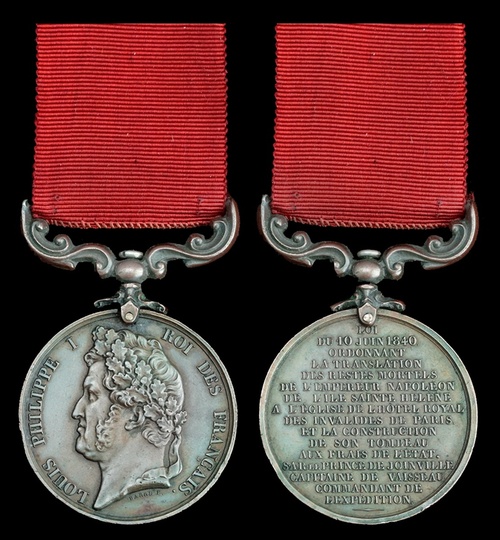
Auction: 18001 - Orders, Decorations and Medals
Lot: 262
Family group:
The rare bronze Legion of Honor Medal awarded to H. Lewis, Royal Sappers & Miners, for his service in exhuming Emperor Napoleon Bonaparte's body from its grave in St. Helena, 1840
France, July Monarchy (1830-48), Legion of Honor, bronze Medal 1840 (H. Lewis S. & M), 36.5mm, marked 'Barre F.', inscribed on reverse: 'Loi du 10 Juin 1840. Ordonnant la translation des restes mortels de l'Empereur Napoleon de l'Ile Sainte Hélène a l'Église de l'Hôtel Royal des Invalides de Paris, et la construction de son Tombeau aux Frais de l'État. Sar le Prince de Joinville Capitaine de Vaisseau Commandant de l'Expédition.', good very fine, housed in wooden box of issue
Three: Sergeant Major J. A. Lewis, Imperial Light Infantry
South Africa 1877-79, 1 clasp, 1879 (7141. Cpl. J. A. Lewis. L.H.), unofficially re-engraved naming; Queen's South Africa 1899-1902, 4 clasps, Cape Colony, Relief of Ladysmith, Wittebergen, Belfast (8 Sjt: J. A. Lewis. Imp: L.I.); King's South Africa 1901-02, 2 clasps, (Sg. Mr. J. A. Lewis, 2nd B.H.), unofficially impressed naming, the second with suspension re-affixed, very fine (4)
H. Lewis was serving on St. Helena with the Royal Sappers & Miners in 1840. Napoleon Bonaparte had been exiled to the island following his defeat at Waterloo in 1815, dying there in 1821. Britain offered to send Napoleon's remains to France following the Emperor's death, but France's political climate did not permit this: the restored King Louis XVIII feared giving Bonapartists a cause to which they might rally.
In 1840 Adolphe Thiers, the French Foreign Minister, persuaded King Louis Philippe of France to begin negotiations with Britain for the return of Napoleon's remains. Thiers saw the 'Retour des Cendres' as a means of rehabilitating Bonapartists, uniting the French people and increasing the government's popularity. François Guizot, the French Ambassador in London, submitted a formal request to the British Government on 10 May. This was immediately approved, and on 26 May the French Parliament voted to raise 1 million francs for the construction of a grand tomb at Les Invalides.
The Prince de Joinville, King Louis Phillipe's third son, was put in charge of the expedition to retrieve Napoleon's corpse. The expedition included General Bertrand, who had fought alongside Napoleon, as well as the Emperor's former servants. On 7 July, the expedition left Toulon aboard the frigate Belle Poule and Favorite, a corvette. After leisurely sojourns to Cadiz, Madiera, Teneriffe and Bahia in Brazil - where Joinville organised 15 days of balls and receptions - the two ships finally reached St. Helena on 8 October. Joinville disembarked on the following day and was received by Major-General George Middlemore, the island's governor, at Plantation House. Middlemore assured Joinville: '...the emperor's mortal remains will be handed over to you on Thursday 15 October.'
Joinville's expedition set off for Longwood, Napoleon's residence on the island. They found his simple tomb covered by three stone slabs and protected by an iron grille fixed to the ground. A weeping willow afforded the tomb some shade. The French expedition were not legally permitted to exhume the body, so the task fell to a small detachment of the British garrison. As a sapper, Lewis was clearly in great demand.
The exhumation was carried out by torchlight on the night of 14 October, and lasted for nine hours. First the iron grille was removed, and then the stones covering the pit. The final stone was lifted at 9:30am on 15 October. Joinville rushed to the scene. He ordered his chaplain, Abbé Coquereau, to sprinkle holy water over the tomb while reciting the psalm De Profundis. The coffin was raised and transported into a large striped pavilion erected the previous day, where the multiple lead and mahogany layers were carefully prized open. Napoleon's body, wrapped in a linen shroud, was miraculously well-preserved. The Emperor was dressed in the uniform of a Colonel of the Guard Chasseurs, his bicorn hat resting on his thigh.
Napoleon's body was transferred into an ebony coffin brought from Paris. Weighing 1,200 kilos, this had to be hauled onto a solid hearse by 43 gunners. At 3:30pm, the cortège moved from Longwood towards the harbour. At 6:30pm, the coffin was embarked on the Belle Poule for its return to France. After passing through a succession of ships, Napoleon's body was eventually reburied at Les Invalides on 15 December.
Louis Philippe subsequently commissioned F. Barre to strike medals for those involved in the 'Retour des Cendres', including Lewis. Each medal was enclosed in a circular wooden case, reputedly cut from the weeping willow which stood by Napoleon's grave on St. Helena. Lewis' medal still has its case.
John Arthur Lewis was born on the Isle of Wight in 1860. He enlisted in the Lonsdale Light Horse Regiment in 1879, taking part in Major Martin's operation which captured the Zulu King Cetshwayo. During the Basuto Campaign, Lewis transferred to Brabant's Light Horse under Major Lowe. He participated in The Jameson Raid during the Transvaal Crisis of 1885-86, before joining the Johannesburg Fire Brigade. Lewis fought as a Sergeant in the Imperial Light Infantry during the 2nd Boer War, but was discharged as medically unfit in 1902.
Lewis moved to Sydney, Australia and died at St. George District Hospital on 19 February 1936. In his possession was the Legion of Honour medal awarded to his father, H. Lewis, in 1840.
Subject to 20% VAT on Buyer’s Premium. For more information please view Terms and Conditions for Buyers.
Sold for
£2,600




